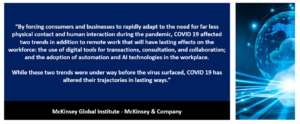Introduction
COVID-19 created a perfect storm that resulted in multiplied crises occurring in public and private sectors globally. The consequences of these pandemic troubles have disturbed lives, pushed the healthcare systems to capacity, limiting supply chain logistics, created a severe economic slowdown, and endangered corporate sustainability and long-term business success. The pandemic upended businesses in all market sectors at an alarming rate, and doing nothing was not a viable choice for business leaders.
As with past crises, major disruptions spurred the need for expeditious imaginative and inventive changes to nullify or weakened the underlining hazards and risks or a shift to new models, practices, and technologies. On the center stage, the development of the vaccines using cutting-edge technologies, including AI / Machine Learning, significantly lessened the time and effort to formulate, develop, and approve the vaccine for distribution. In addition, cloud computing services enabled large and small businesses to relocate their employee population to remote settings, shift capital expenditures (CAPEX) to operational expenses (OPEX), and streamline their internal and external processing.
 The widespread business acceptance of cloud platform services was well underway when COVID-19 became severe health and economic predicament globally in March 2020.
The widespread business acceptance of cloud platform services was well underway when COVID-19 became severe health and economic predicament globally in March 2020.
The pre-pandemic cloud users’ original decisions supported their goals for improved cost optimization, data security, and technology modernization. Fortunately, these companies were well-positioned to react to the business risk that was becoming a reality. They quickly leveraged and relocated elements of their processing and data activities to their cloud platform and avoided the financial damages from the lockdowns and restrictions. In addition, being cloud-ready enabled them the flexibility to choose the most optimal solutions and services for their now-distributed teams, rather than depending on processes rooted in pre-Covid workplace methods.
This business group was better able to shield against the many hurdles faced daily by the businesses who had not yet moved to the cloud and could exploit competing opportunities with improved ‘speed to market’ structure and virtual interactions.
2020 bolstered that cloud computing was a vital tool in assisting businesses to adjust and conform to a future of uncertainty within a ‘new normal’ environment.
“The first months of 2020 separated the digitally mature from the pack. In response to COVID-19’s economic chaos, including disrupted supply chains; shutdowns in physical facilities; and a shift in priorities from growth to health and safety, the companies best able to pivot were those that were already well into their cloud journeys. Such firms leveraged a cloud foundation to support remote workers; protect data assets; serve clients and partners; and change, update, and manage critical business software on the fly.”
Frost & Sullivan
COVID-19 created a volatile business cycle with intense downturns and quick but uneven recoveries. As businesses adapt to the ‘new normal,’ they need to plan for the realities of managing work within an economic landscape and technological environment much different from a few years ago.
A primary strategic priority demands the substantiation of the pros and cons of recent and planned technology investments, including cloud platform adoption. In addition, the pros should validate and confirm the value realized from security and data protection, data modernization, and operational efficiency. The critical deliverable of this exercise is to ensure the corporate technologies empower the achievement of the business strategies and financial plan success.
The absence of go-forward planning following an internal or external crisis can have a devastating effect on organizations. Success in recovering markets requires revisiting the enterprise strategy to ensure that it acknowledges the current and forward economy, market trends, best practices and focuses investments and resources on the high-priority customer buying behaviors and support needs.
Cloud Reflection and Rethink
The past year has challenged long-held traditions and assumptions and caused many companies to reexamine every aspect of their business. The COVID-19 crisis fundamentally changed the traditional work environment and the proverbial buyer experience. As a result, the business community needed to rethink and respond to the established workplace policies and practices emerging from obligatory lockdowns, office repurposing, and employee and customer safety concerns. Companies generally obtained immediate advantage from their cloud investment; however, some encountered difficulties understanding the cloud technology and vendor platform capabilities, technical and support services, and pricing.
Over the years, cloud computing has evolved from its original intent in augmenting organizational IT activities. Initially, the cloud offered another means to obtaining computer and storage services. These services generally increased agility and lowered cost but did not result in a business transformation. Today, the focus is the provision of services that directly contribute to the success of business strategies. The preeminent Cloud Service Providers (CSPs): Microsoft Azure, Google Cloud, and Amazon Web Services (AWS) offer a range of innovative business-focused solutions enabling organizations to pivot from developers of IT systems to assemblers of business capabilities. With these novel technical capabilities, companies can immediately improve their corporate creativity and versatility, autonomy to explore and create futuristic and inventive products and services, with the capacity to scale quickly.
“In today’s era of volatility, there is no other way but to re-invent. The only sustainable advantage you can have over others is agility, that’s it. Because nothing else is sustainable, everything else you create, somebody else will replicate.”
Jeff Bezos
The cloud is a disruptor, and most business leaders finally realize that their business units are the driving force behind the innovation that customers demand. It is mission-critical that corporate leadership continually examine and value the new and emerging business-directed cloud services. For example, the cloud providers’ most attractive transformational services include cloud-native applications, blockchain, machine learning, and artificial intelligence, which are prime candidates for consideration in a revisit of cloud priorities with enterprise goals and strategies. With the cloud providing the required infrastructure, best-in-class businesses can maintain or attain competitive advantage from their bold and intelligent design and delivery of differentiated customer value propositions.
The World Economic Forum identified three ways businesses can survive and thrive through COVID-19 and beyond, as shown below.
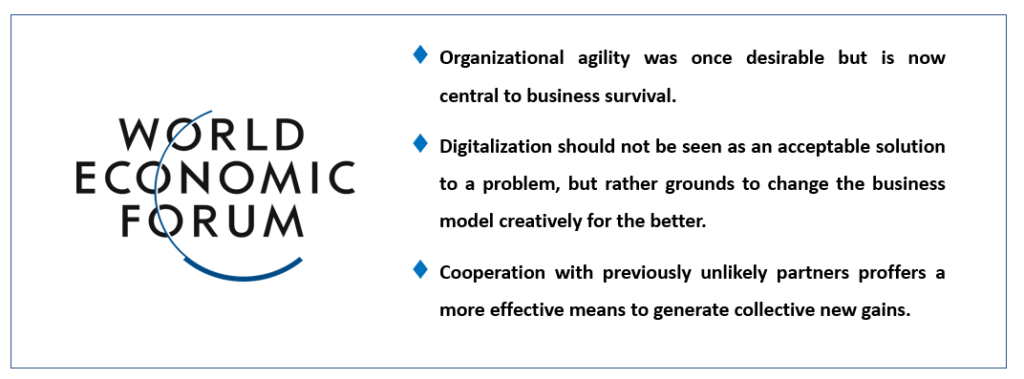 With the transition to the ‘new normal,’ business leaders now need to take a time out and review their original cloud plans, contracts, ROI, and budgets in tandem with the new post-COVID-19 market realities and improve their cloud plan accordingly. Successful cloud deployment requires strategic insight and agility. Realizing the full benefits of a cloud strategy demands the proactive (walking the talk) engagement and consensus of the entire executive team. This objective is supportable with the leadership prioritizing and directing a hands-on strategic value assessment of the corporate cloud plan.
With the transition to the ‘new normal,’ business leaders now need to take a time out and review their original cloud plans, contracts, ROI, and budgets in tandem with the new post-COVID-19 market realities and improve their cloud plan accordingly. Successful cloud deployment requires strategic insight and agility. Realizing the full benefits of a cloud strategy demands the proactive (walking the talk) engagement and consensus of the entire executive team. This objective is supportable with the leadership prioritizing and directing a hands-on strategic value assessment of the corporate cloud plan.
“Throughout 2021, we can expect to see the rate of this change accelerate as more businesses get to grips with adopting cloud models, and delivery of data from the cloud to our devices becomes more integral to our daily lives.”
Forbes
The Strategy Imperative: Intelligent Decisions
Today every company is a technology business or at least a technology-enabled enterprise. The pervasiveness of technology across all business activities makes it a strategic imperative to view technology and especially the cloud as mission-critical to digital transformation, sustainability, and profitability.
Adopting cloud computing in a corporate setting demands not just the selection of an appropriate cloud solution! Success in this endeavor also requires designing a cloud strategy driven by the business and aligned with the technology strategy. A cross-functional team of business and technology executives should conduct an enterprise business value assessment to confirm the suitability and value of an existing or planned cloud platform solution. The prime deliverable is a consensus ‘go’ or ‘no-go’ decision on cloud appropriation. A ‘go’ choice renews the corporate business and technology strategies and produces a roadmap for the purchase and set-up of the cloud services. This exercise is crucial to building a distinct approach and actionable plans to leverage cloud computing to support real business needs. The outcome ensures the alignment of the organization’s goals and strategies and supports the transition from the ‘As-Is’ to To-Be’ operating environment.
“Cloud computing is becoming a mainstream part of the IT world, with far-reaching impacts for many businesses. It’s crucial, therefore, that IT leaders and enterprise architects prepare an overarching cloud strategy for their organizations.”
Gartner
The Business Value Assessment Model is a framework employed to assess technology investments, including cloud computing. The graphic below displays a high-level illustration of the primary elements facilitating a formalized analysis and generation of a cloud computing ‘go’ or ‘no-go’ decision and supporting strategies and plans.
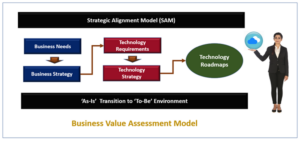
Outlined below is the description of the prime components of the Model.
Strategic Alignment Model (SAM)
Strategic alignment links and enables a company’s business and IT structure and resources to adapt to the business environment and technological changes within the corporate business model. This approach enables higher performance by optimizing the cohesive contributions of people, processes, and technologies to realize measurable goals and successful strategies, thus, minimizing waste, improving productivity, increasing profitability, and misdirecting resources to unplanned or unspecified purposes. These conditions are possible because all business units collaborating within the SAM strive towards a common purpose in complete harmony with its enterprise IT strategies and initiatives.
“One in three cloud migrations fail due to companies not adopting the cloud as a core part of their business strategy.”
Unisys Corporation
Strategic alignment is a practice and not a point-in-time event and continual movement recognizing and adapting to necessary corporate changes and enrichment. The cloud computing solution is an example of a technology assessed for advantage within an aligned business and technology model.
‘As-Is’ Transition to ‘To-Be’ Environment
Well-managed organizations continually test the effectiveness and value of their current (As-Is) operating activities, processes, and technologies as supported by corporate culture, goals, policies, and strategies. At the same time, they vigorously investigate new or emerging technologies and best practices and their potential use within their organization.
Within this structure, the executive team needs to proactively re-engineer the business model to ensure future sustainability and improved competitiveness in an imperious marketplace. Thus, there is a delicate balance in the ‘As-Is’ to ‘To-Be’ transition setting with a likelihood of overlap for an extended period.
The cloud computing assessment requires a positive value acceptance ‘within the ‘As-Is’ environment and the ‘To-Be’ if developed and planned for implementation. It will be necessary for those businesses without a formalized ‘To-Be’ design to perform ‘what-if’ scenarios to confirm the future value and identify any potential risk or problematic conditions.
Business Needs / Business Strategy
Technology is at the core of today’s business transformation, empowering companies to modernize their business and respond swiftly to competitive threats and be ready to exploit new opportunities. Even so, technology is a tool that can be used or misused! For this reason, it is essential that business unit executives proactively drive the identification of the business needs to maintain and strengthen the business model. The basis for the cloud assessment acknowledges that it focuses on the total holistic enterprise and identifies specific business demands and benefits.
Cloud computing business needs vary based on the unique company culture, business model, and financial and people resources availability. Nonetheless, cloud solutions’ primary values facilitate decreased operating costs, more productive infrastructure, modern cloud-based product development and delivery, expanded scaling capability and capacity, and robust privacy and security provision.
Best practices reveal that examining the below points specific to the enterprise’s current ‘As-Is’ and planned ‘To-Be’ environments provide essential answers and statistics to recognize a cloud solution’s potential pros and cons.
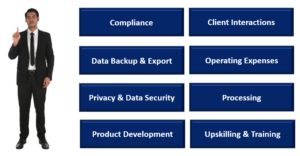
After assessing the potential of the cloud technology solution, there is a ‘go’ or ‘no-go’ decision point.
If a positive response, the business needs are translated into opportunities that can be leveraged or exploited with the cloud solution in an updated Business Strategy.
Business strategies ensure coherence in allocating corporate resources and establishes a framework for the success of the technology-enabled initiatives required to accomplish its goals and financial plan objectives.
“A cloud strategy is a concise viewpoint on the role of cloud computing in your organization. It’s different from a cloud implementation plan, which offers the “how” rather than the “what” and “why” questions of a cloud strategy. It is not an attempt to solve everything nor a plan to move everything to the cloud.”
Gartner
Technology Requirements / Technology Strategy
The technology executives and team convert the approved business needs into supporting technical requirements and identify the proper technical solutions or products required for development or acquisition. Within this charter, they determine if a cloud solution can add value by improving the existing communications and processing for internal and external activities and produce quantifiable benefits. Assessing the merits of a cloud solution’s technical specifications covers one or more cloud platforms and services, hardware, and a Cloud Management Platform (CMP).
What are the pluses and minuses, and is there a significant value for creating a cloud strategy? The following elements provide a starter list to analyze, challenge and reach a consensus on the company’s responses to the potential value of a cloud solution. In addition, analyzing the generic cloud platform services and pricing below is essential in reaching conclusions and planning a ‘go’ or ‘no-go’ decision on cloud platform adoption.
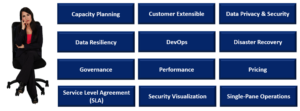
Adopting a cloud solution entails identifying high-impact dependencies and the associated internal or external (customer-facing) process changes. Failure to recognize these developments and create appropriate mitigation actions could result in higher costs and customer financial impacts, negating the planned cloud solution benefits. Therefore, the Technology Strategy needs to confirm the business unit’s needs and possible workplace changes with a filter that confirms the limitations or opportunities with existing technology that cloud computing can potentially address and improve with quantifiable benefits.
Current Cloud Trends
Research and analysis are critical to identifying the usefulness of industry-accepted and emerging trends in cloud computing with potential consequences on internal and external activities. Outlined below are the top current trends requiring study and decisions to support an effective cloud strategy.

“Simply migrating systems to the cloud without also thoughtfully implementing cyber strategy, agile, and DevOps, for example, would leave a company unable to take advantage of the automation, scale, and flexibility that cloud-based systems offer.”
McKinsey
Analysis Tools
Traditional analysis tools help identify the prevailing cloud best practices and challenges, key competitor cloud preferences, calculate costs and benefits, financial and non-financial schedules, and identify likely changes to the workplace.
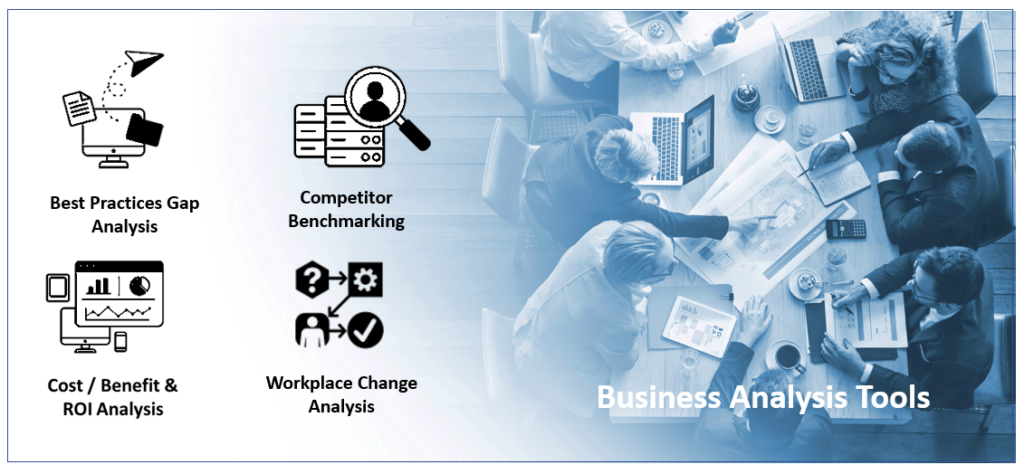
The supporting descriptions of the business analysis tools are below.
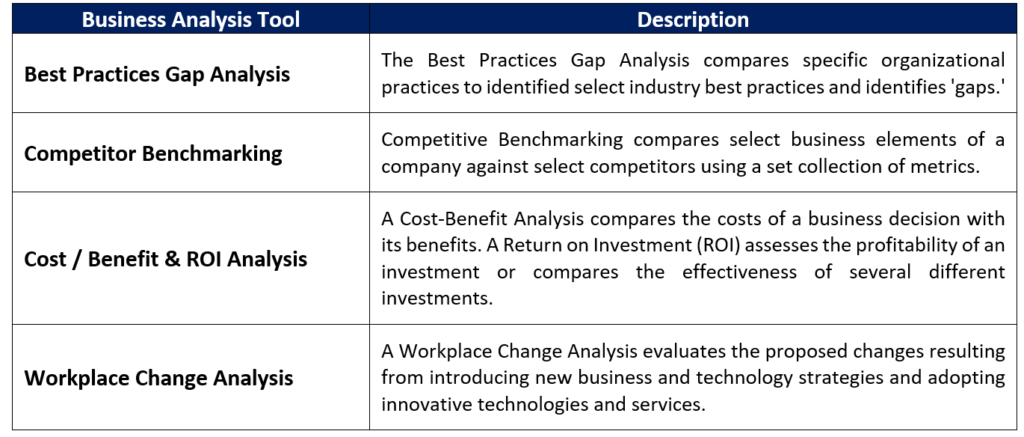
If these analyses’ outcome validates the positive business units’ cloud decision, the Technology Strategy is updated and appropriately aligned with the renewed Business Strategy.
“The economics of cloud computing is both controversial and complicated. On the one hand, cloud provides access to automated capabilities that enterprises could never afford to develop on-premise, and cloud service providers (CSPs) leverage inverse correlation of workload usage patterns to run their assets at much higher utilization. On the other hand, CSPs charge based on consumption, and companies must remediate existing applications for them to run efficiently in the cloud.”
McKinsey
Technology Roadmap
Disruptive technologies like the cloud are transforming most business activities with a paradigm shift to on-demand hyper-scale computing services. However, just plugging into the cloud will not create value. Instead, business leaders must think and work differently and have a reliable, secure, and flexible cloud strategy to enable successful outcomes.
Shifting to the cloud can be a transformative shift for the entire organization. Many things in this world are one-size-fits-all. However, cloud computing is not one of them. Each company has its unique conditions and specifications for its solution, based on market-driven business and technology considerations. Successful cloud adoption requires the planning and executing a comprehensive Technology Roadmap that creates a formalized framework for contract negotiations, migration, and go-live. It is necessary to convert the technology requirements into a cloud technology roadmap at this stage of the journey.
The Technology Roadmap consists of three distinct phases:
- Cloud Specification
- Vendor Selection
- Migration Plan
Cloud Specification
The cloud specifications provide the framework for the planned design of the cloud solution to support the technology requirements generated from the conversion of the approved business needs.
The specifications contain three critical high-level decisions necessary to finalize the Technology Roadmap, as depicted on the adjacent graphic.

Cloud Deployment Model
The Model is a distinct configuration of technical parameters, including proprietorship of the deployment infrastructure, where it resides, accessibility, and storage size.
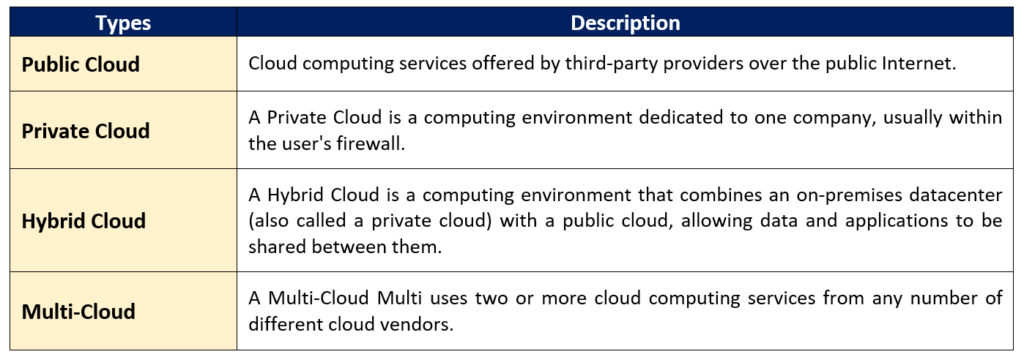
Increasingly, the business community is adopting public/private, hybrid cloud setups. Given the complexity of today’s digital-enabled commerce, no individual cloud structure can support the total needs of all types of companies. As a result, a substantial amount of the company portfolio remains on-premises in a private, hybrid cloud architecture. At the same time, less sensitive data and workloads relocate to one or more public clouds.
Cloud Service Category
This component consists of a wide range of services delivered on-demand over the internet. These services provide affordable access to applications and resources without internal infrastructure or hardware. The selection of a cloud service provider determines the variety of specific cloud services available. The three preeminent providers: Microsoft Azure, Google Cloud, and Amazon Web Services (AWS), provide an extensive catalog of services to support business requirements.
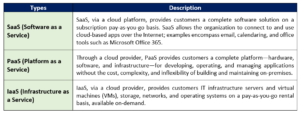
Cloud Migration Approach
The approach moves digital assets, services, databases, IT resources, and applications, either partially or wholly, into the cloud. Cloud migration is also about moving from one cloud to another.

Vendor Selection
Today, engagement in a B2B pre-sales process with one or more cloud platform providers typically commences after the business units and IT complete the required investigation and business and technical-based decisions. At this point, the company is purchasing versus being sold a cloud solution as they have completed the necessary research and analysis to finalize their business and technology strategies.
Cloud Service Providers (CSP)
The Cloud Service Providers (CSP) field has countless competitors, including the big three: Amazon Web Services (AWS), Microsoft Azure, Google Cloud Platform (GCP), and various niche players offering specialized bespoke cloud services. Currently, there is a lack of a standard method for evaluating CSPs and products. Additionally, there is no regularity in provider content, product specifications, support services, and pricing schedules. The lack of standardization reinforces the challenge of performing a proper comparative analysis of targeted providers. These conditions add a high level of uncertainty to the selection process and complicate the finalization of vendor and product decisions.
Technology acquisition traditionally is not a riskless exercise as even the best-planned and executed plans may meet unforeseen dangers and failure. Therefore, choosing the best provider is a critical determination that will ultimately influence cloud adoption and successful migration. Therefore, the best course of action to avoid difficulties is formalizing the cloud solution choice with a structured approach consisting of the below elements.
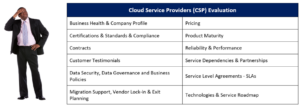
Currently, mistakes in understanding cloud capabilities and their use are prevalent throughout the business community. There is a shortage of highly skilled individuals available for employment, especially at SMB companies. In many cases, executives and managers are making decisions beyond their level of knowledge and experience. Nevertheless, the risk is controllable using senior technology employees and consultants with appropriate experience and skills handling vigorous pre-sales activities and contract negotiations. For example, a critical task is to confirm that the company’s Business and Technology Strategies and the Technology Roadmap meet and harmonize with the vendor platform services and features to ensure the availability and support of the required technical capabilities and facilities.
The Contract
The cloud platform contract summarizes the company’s arrangements with the cloud platform vendor during the pre-sales and contract negotiations. Unfortunately, vendor contracts occasionally fail to incorporate previously agreed terms and conditions or lack the clarity necessary to agree and accept quickly. Outlined below are vital customer protection topics that require positive responses and approved inclusion in the agreement before contract sign-off.
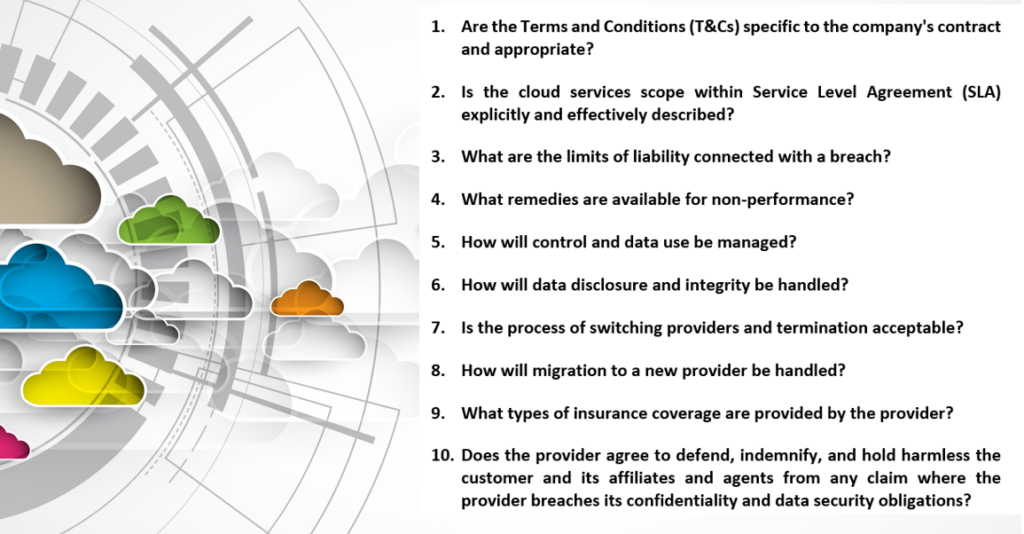
Migration Plan
The Migration Plan, an outcome of the company’s Cloud Specification decisions and contract with the cloud platform vendor, produces the framework for relocating data, applications, and workloads from the on-premises architecture to the cloud. The Plan drives the migration by answering what, how, and when to relocate to the chosen cloud platform. The Plan should include separate phases and resources for each targeted application and determines the priority, sequence, and amount of change planned for each application and how quickly the applications will advance through migration to production.
Project Management
The Project Plan operationalizes the cloud migration planning and directly supports the approved business and technology goals and strategies. The Project Plan enables a structured migration with required team members with specific roles and responsibilities, suitable technical scope, approach, schedule, and deliverables. The high-priority components ensuring an effective and problem-free cloud migration and fulfillment of planned benefits follow below.
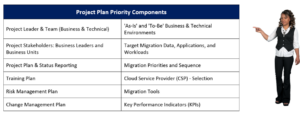
Migration Tools
Many legacy applications are not optimized for the cloud, so they must be adapted with capabilities explicitly designed for the assignment. Migration tools are indispensable for a successful project because they simplify and accelerate migration with minimal disruption to the day-to-day business activities. The top commercially available tools reduce the complexities of migration and speed of relocating an organization’s data, applications, and workloads to a cloud infrastructure. The primary types of migration tools include SaaS, Open Source, and Batch Processing.
Migration tool selection must be compatible with the company’s operating systems and platforms. It is also essential that the tools provide capabilities including monitoring, reporting, and graphing capabilities that enable tracking and documenting the cloud migration project.
Risk Management
A risk is an event with a probability of occurring and could positively or negatively impact a project should that risk occur. A risk may have one or more causes and, if it occurs, one or more impacts.
Cloud migration activities typically experience project and technical issues that may result in uncertainty and indecision with a significant downside if left unattended and ignored. The principal triggers of migration risks are a lack of cloud services understanding and poor decision-making in selecting and adopting cloud services in migration and production. They include:

The risks that are commonly associated with could migration include the below.
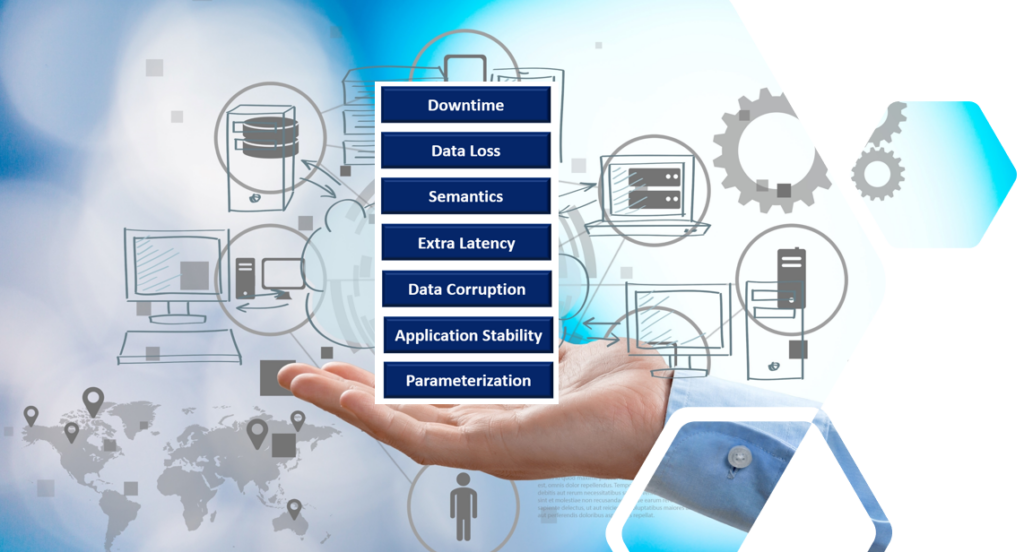
Good practices prescribe that risk management starts before project initiation to identify and understand potential migration vulnerabilities and risks with severe consequences. This exercise determines the probability of risk occurrence and degree of possible impact to the planned migration schedule, scope, cost, and quality. This practice is a “cause and effect” discovery. The “cause” is the risk that may occur, while the “effect” is the potential consequence to a project with the risk outcome.
Risk cases may touch one or multiple migration activities. All potential risks identified are classified with a risk priority, included in a Risk Register, and assigned to a project team member for monitoring and mitigation actions throughout the project lifecycle. The risks deemed as the most critical are candidates for the completion of a comprehensive contingency plan executed, within the project, as a pre-emptive approach or following risk recognition and analysis.
Cloud Services Metrics
Metrology – the science of measurement is essential for cloud computing, not just for the measurement of cloud services but also to gain a common understanding of the properties themselves. Metrics provides valuable insight into a cloud property’s characteristics through its definition, including expression, unit, rules, and the values resulting from the measurement.
Metrics enable the executive team to better comprehend its corporate cloud services’ performance through consistent, reproducible, and repeatable measurements. For example, organizations use (KPI) key performance indicator (KPI) metrics to measure specific cloud-based achievements, and benchmark metrics can be used as a reference to compare features against one another.
Cloud metrics used by CSPs, consultants, and the academic community come in many varieties. Rule one in designing a metric measurement activity is to ensure alignment with the enterprise goals and strategies. Outlined below are examples of generic cloud metrics recently mentioned or referenced in articles and seminars.

The Flexera 2021 State of the Cloud Report identified their ten top metrics for organizational ‘cloud progress,’ as shown in the graphic below.
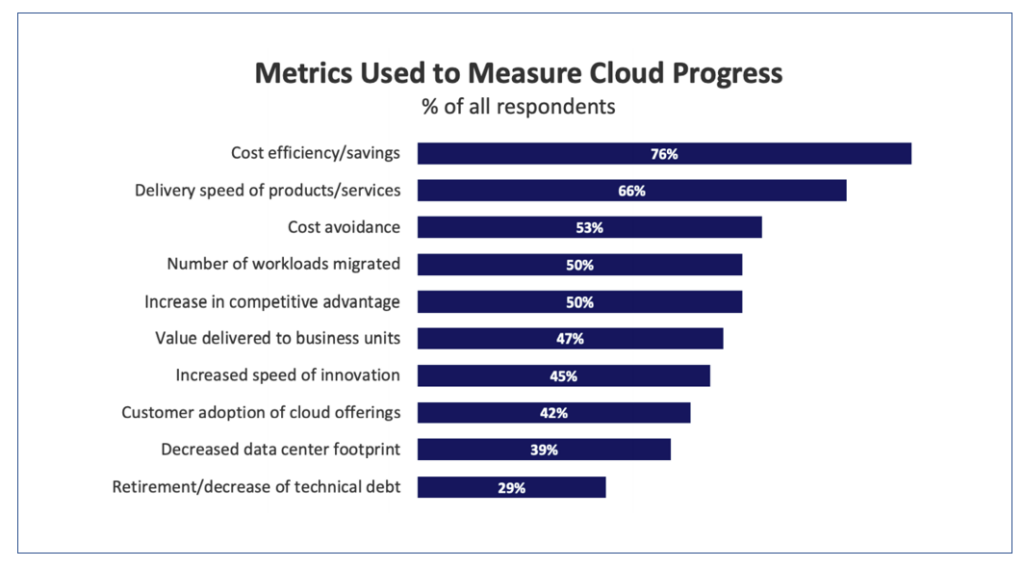
“With the mounting evidence of cloud’s ability to drive significant business value, more and more companies are considering cloud’s role in fundamentally reshaping the competitive posture of their business.”
McKinsey
The Way Forward
At Knowledge Compass, we bring together nearly four decades of thought leadership in business and technology strategy, the latest tools and best practices, and a seasoned consultant team with the competencies and talent to help our clients improve productivity and profitability.
Knowledge Compass explores and develops valuable new insights from business, technology, and science by embracing the powerful technology of ideas and brainstorming. Our consultants engage customers in challenging discussion and experimentation to expand business science boundaries and practice and translate creative ideas into practical solutions from within and beyond business.
Working with Knowledge Compass means a collaborative approach to understanding your current business model, strategies, and critical business requirements and goals.
We enable organizations to transform and deliver improved value by ensuring employees adapt and make the most effective use of crisis management and change practices in culture, strategy, infrastructure, processing, and digital transformation. Our consultants have a deep understanding of the social and business factors that support a people-based culture aligned with the appropriate corporate strategy and goals.
Knowledge Compass provides consulting services using time-tested best practice frameworks, analysis tools, and interactions from their professional Consultant Toolbox.
